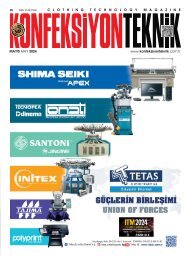Create successful ePaper yourself
Turn your PDF publications into a flip-book with our unique Google optimized e-Paper software.
21<br />
potential for vulnerability to injury,” said Medical Dr. Yonga<br />
said, “Wrist injuries can occur due to various factors such as<br />
falls, impacts, repetitive movements, fractures or sprains.<br />
Taking protective measures and paying attention to proper<br />
ergonomics can reduce wrist injuries. It is important to use<br />
protective equipment and perform repetitive movements<br />
carefully, especially during risky activities.”<br />
These diseases cause pain in the wrist!<br />
Noting that some diseases, independent of trauma, can<br />
also cause pain in the wrist, Medical Dr. Yonga Dr. Yonga<br />
explained the following on the subject, “The most common<br />
wrist disorders are inflammation of the tendons in the<br />
wrist (tendinitis-tenosynovitis), compression of the median<br />
nerve in the wrist (carpal tunnel syndrome), inflammation<br />
of the tendons on the side of the thumb (de quervain<br />
tenosynovitis), stretching or tearing ligaments in the wrist,<br />
formation of fluid-filled sacs in the tendon or joint capsule<br />
of the wrist (ganglion cysts), fracture or sprain of the wrist<br />
bones and accumulation of uric acid in the joints.”<br />
The character of the pain is an important clue<br />
Stating that the character of wrist pain provides an<br />
important clue in determining the underlying problem, Dr.<br />
Yonga explained the following about these signs, “While<br />
sharp-sudden onset of pain may occur due to fracture,<br />
sprain, ligament injury or acute trauma, smooth and slowonset<br />
pain may be due to chronic overuse tendinitis. The<br />
fact that the pain wakes the patient up at night, that the<br />
patient feels the need to shake his hands, and that he<br />
frequently starts to drop objects such as glasses and plates<br />
from his hands due to loss of strength, makes us think<br />
of carpal tunnel syndrome. Swelling accompanying pain<br />
may occur in ganglion or other soft tissue masses. These<br />
characteristics are important for a healthcare professional<br />
in the clinical evaluation and diagnosis process. In addition,<br />
details such as the onset of pain, its severity, frequency,<br />
and sensitivity to other factors should also be evaluated. It<br />
should not be forgotten that everyone’s perception of pain<br />
is different and the same type of pain may occur due to<br />
different reasons.”<br />
tenosinoviti), el bileğindeki bağların gerilmesi veya<br />
yırtılması, el bileğindeki tendon veya eklem kapsülündeki<br />
sıvı dolu keseciklerin oluşması (ganglion kistleri), el bileği<br />
kemiklerinde kırık veya burkulması, ürik asidin eklemlerde<br />
birikmesi el bileği rahatsızlıklarından en sık görülenleridir.”<br />
Ağrının karakteri önemli ipucu<br />
El bileği ağrısının karakterinin altta yatan sorunu<br />
belirlemede önemli bir ipucu sağladığını söyleyen<br />
Op. Dr. Yonga, bu işaretlerle ilgili şunları anlattı:<br />
“Keskin-ani başlangıç gösteren ağrılar kırık burkulma<br />
bağ yaralanması veya akut travma ile oluşabilirken,<br />
düzgün ve yavaş başlayan ağrılar kronik aşırı kullanıma<br />
tendinitlere bağlı görülebilir. Ağrının gece uykudan<br />
uyandırması, hastanın ellerini sallama ihtiyacı hissetmesi,<br />
elinden bardak tabak gibi nesneleri güç kaybına bağlı<br />
sık düşürmeye başlaması bize karpal tünel sendromunu<br />
düşündürmektedir. Ağrıya eşlik eden şişlik oluşumu ise<br />
ganglion veya diğer yumuşak doku kitlelerinde karşımıza<br />
çıkabilmektedir. Bu karakteristik özellikler, bir sağlık<br />
profesyoneli için klinik değerlendirme ve tanı koyma<br />
sürecinde önemlidir. Ayrıca, ağrının başlama süreci,<br />
şiddeti, sıklığı ve başka faktörlere duyarlılık gibi detaylar da<br />
değerlendirmeye alınmalıdır. Unutulmamalıdır ki, herkesin<br />
ağrı algısı farklıdır ve aynı tip ağrı farklı nedenlere bağlı<br />
olarak ortaya çıkabilir.”<br />
Bileği ince olanlar daha fazla dikkat etmeli!<br />
Kişinin bileğinin ince veya kalın yapıda olması da<br />
el bileğinde yaşanabilecek sorunlar açısından risk<br />
oluşturabileceğini söyleyen Op. Dr. Yonga, ince bir bilek<br />
genellikle daha az yumuşak dokuya sahiptir, bu da<br />
kemiklerin ve diğer yapıların dış etkenlere karşı daha<br />
zayıf olmasına yol açabilir. İnce bileklerde tendonlar ve<br />
bağlar daha belirgin olabilir ve bu da bu yapıların dış<br />
Those with thin wrists should pay more attention!<br />
Recording that whether a person’s wrist is thin or thick may<br />
pose a risk for problems that may occur in the wrist, Dr.<br />
Yonga said that a thin wrist generally has less soft tissue,<br />
which can lead to bones and other structures being more<br />
vulnerable to external factors. Tendons and ligaments<br />
may be more prominent in thin wrists, causing these<br />
structures to become more sensitive to external factors.<br />
When individuals with thin wrists are exposed to the same<br />
forces, this force may be felt more on the individual’s wrist,<br />
thus increasing the risk of injury. It should not be forgotten<br />
that wrist structure is not the sole determinant of wrist<br />
problems. A number of factors may also be influential, such<br />
as activity levels, age, general health, exercise habits and<br />
work conditions.<br />
<strong>Ocak</strong> - January <strong>2024</strong>

















